Overview of Transient Simulations of Grounding Systems under Surge Conditions
Abstract
:1. Introduction
- the metallic conductor that drives the current to the electrode;
- the electrode that is buried in the soil;
- the ground around the electrode. (It may be mentioned that the analysis of the behavior of the soil is the most important.)
2. Materials and Method
3. Model in ATPDraw
4. Example of Model Validations
5. Conclusions
- −
- peak of the impulse current;
- −
- length of the rod that composes the grounding system;
- −
- resistivity of the soil;
- −
- critical electric field of the soil.
Author Contributions
Funding
Institutional Review Board Statement
Informed Consent Statement
Data Availability Statement
Acknowledgments
Conflicts of Interest
References
- Tete, P.; Hasnaoui, F.S.; Georges, S. Analysis of the lightning transient response of the grounding system of large wind farms. In Proceedings of the 2020 5th International Conference on Renewable Energies for Developing Countries (REDEC), Marrakech, Morocco, 29–30 June 2020; pp. 1–6. [Google Scholar] [CrossRef]
- Kisielewicz, T.; Blicharz, G.; Mazzetti, C.; Mosti, G.; Tofani, A.; De Carli, D.; Montarese, V. Technical and legal aspects of critical infrastructure protection. Law Action 2018, 36, 65–75. [Google Scholar]
- Mitolo, M. On the New Terminology Introduced in Std. IEEE P3003.2 “Recommended Practice for Equipment Grounding and Bonding in Industrial and Commercial Power Systems”. In Proceedings of the 2015 IEEE/IAS 51st Industrial & Commercial Power Systems Technical Conference (I&CPS), Calgary, AB, USA, 6–8 May 2015; pp. 1–5. [Google Scholar]
- Blicharz, G.; Kisielewicz, T. Legal aspects of governing the commons against technical challenges of smart city development. Forum Praw. 2017, 39, 34. [Google Scholar]
- Kisielewicz, T.; Blicharz, G. An interdisciplinary approach to service continuity provision of power systems. In Proceedings of the Medial International Scientific Conference of the Series: Decisions in Situations of Endangerment, Wroclaw, Poland, 23 November 2017; General Tadeusz Kościuszko Military University of Land Forces in Wrocław: Wrocław, Poland, 2017. [Google Scholar]
- Jambak, M.I.; Ahmad, H. Measurement of grounding system resistance based on ground high frequency behavior for different soil type. In Proceedings of the 2000 TENCON Intelligent Systems and Technologies for the New Millennium (Cat. No. 00CH37119), Kuala Lumpur, Malaysia, 24–27 September 2000; Volume 3, pp. 207–211. [Google Scholar] [CrossRef]
- Lian, D.; Bo, Z.; Jinliang, H.; Leishi, X.; Qian, L. Experimental study on transient characteristics of grounding grid for substation. In Proceedings of the 2016 33rd International Conference on Lightning Protection (ICLP), Estoril, Portugal, 25–30 September 2016; pp. 1–6. [Google Scholar] [CrossRef]
- Kisielewicz, T.; Lo Piparo, G.B.; Mazzetti, C.; Fiamingo, F. Impact of an extended grounding system on the factors affecting selection of an SPD system for apparatus safety. Electr. Rev. 2016, 92, 51–53. [Google Scholar] [CrossRef] [Green Version]
- Lo Piparo, G.B.; Kisielewicz, T.; Mazzetti, C.; Fiamingo, F. Protection of apparatus against lightning surge in an extended earthing arrangement. In Proceedings of the 16 IEEE International Conference on Environment and Electrical Engineering, Florence, Italy, 7–10 June 2016. [Google Scholar]
- Lo Piparo, G.B.; Kisielewicz, T.; Fiamingo, F.; Mazzetti, C. Influence of grounding conditions on apparatus protection by means of SPD. In Proceedings of the XXIII International Conference on Electromagnetic Disturbances (EMD 2015), Białystok, Poland, 9–11 September 2015. [Google Scholar]
- Yang, S.; Zhou, W.; Huang, J.; Yu, J. Investigation on Impulse Characteristic of Full-Scale Grounding Grid in Substation. IEEE Trans. Electromagn. Compat. 2018, 60, 1993–2001. [Google Scholar] [CrossRef]
- Kisielewicz, T.; Lo Piparo, G.B.; Mazzetti, C.; Fiamingo, F. Factors influencing the probability of an apparatus damage in an extended earthing arrangement. In Proceedings of the International Conference on Lightning Protection 2016, Estoril, Portugal, 25–30 September 2016. [Google Scholar]
- Permal, N.; Osman, M.; Kadir, M.Z.A.A.; Ariffin, A.M. Review of Substation Grounding System Behavior under High Frequency and Transient Faults in Uniform Soil. IEEE Access 2020, 8, 142468–142482. [Google Scholar] [CrossRef]
- Sekioka, S. Discussion of current dependent grounding resistance using an equivalent circuit considering frequency-dependent soil parameters. In Proceedings of the 2016 33rd International Conference on Lightning Protection (ICLP), Estoril, Portugal, 25–30 September 2016; pp. 1–6. [Google Scholar] [CrossRef]
- Gazzana, D.S.; Tronchoni, A.B.; Bretas, A.S.; Pulz, L.T.; Ferraz, R.G.; Telló, M. A Transmission Line Modeling (TLM) Algorithm to Evaluate Grounding Grids Including Soil Ionization. In Proceedings of the 2020 IEEE International Conference on Environment and Electrical Engineering and 2020 IEEE Industrial and Commercial Power Systems Europe (EEEIC/I & CPS Europe), Madrid, Spain, 9–12 June 2020; pp. 1–4. [Google Scholar] [CrossRef]
- Yassin, S.; El Dein, A.Z. Transient performance of horizontal grounding electrode under soil ionization effect. In Proceedings of the 2017 Nineteenth International Middle East Power Systems Conference (MEPCON), Cairo, Egypt, 19–21 December 2017; pp. 796–801. [Google Scholar] [CrossRef]
- Towne, H.M. Impulse characteristics of driven grounds. Gen. Electr. Rev. 1929, 31, 605–609. [Google Scholar]
- Ivonin, V.V. Experimental Investigation of Impulse Resistance of Different Type Grounding Electrodes. In Proceedings of the 2020 International Multi-Conference on Industrial Engineering and Modern Technologies (FarEastCon), Vladivostok, Russia, 6–7 October 2020; pp. 1–4. [Google Scholar] [CrossRef]
- Zhang, F.; Tanaka, H.; Baba, Y.; Nagaoka, N. FDTD surge simulation of a vertical grounding rod considering soil ionization. In Proceedings of the 2016 Asia-Pacific International Symposium on Electromagnetic Compatibility (APEMC), Shenzen, China, 18–21 May 2016; pp. 260–262. [Google Scholar] [CrossRef]
- Gao, Y.Q. Research on Mechanism of Soil Breakdown and Transient Characteristics of Grounding Systems. Ph.D. Thesis, Tsinghua University, Beijing, China, 2003. [Google Scholar]
- Fajingbesi, F.E.; Shahida Midi, N.; Elsheikh, E.M.A.; Hajar Yusoff, S.; Khan, S.; Azman, A.W. Induced Current Distribution in 3D Soil Model as Lightning Impulse Discharge Strike Earth Surface. In Proceedings of the 2019 9th International Conference on Power and Energy Systems (ICPES), Perth, Australia, 10–12 December 2019; pp. 1–6. [Google Scholar] [CrossRef]
- Kumar, A.S.; Manickavasagam, K. Mathematical modelling of dynamic soil resistivity under transient conditions. In Proceedings of the 2017 International Conference on Technological Advancements in Power and Energy (TAP Energy), Kollam, India, 21–23 December 2017; pp. 1–6. [Google Scholar] [CrossRef]
- Kherif, O.; Chiheb, S.; Teguar, M.; Mekhaldi, A.; Harid, N. Time-Domain Modeling of Grounding Systems’ Impulse Response Incorporating Nonlinear and Frequency-Dependent Aspects. IEEE Trans. Electromagn. Compat. 2018, 60, 907–916. [Google Scholar] [CrossRef]
- Mokhtari, M.; Abdul-Malek, Z.; Gharehpetian, G.B. A critical review on soil ionisation modelling for grounding electrodes. Arch. Electr. Eng. 2016, 65, 449–461. [Google Scholar] [CrossRef]
- Chiheb, S.; Kherif, O.; Teguar, M.; Mekhaldi, A. Incorporation of soil ionization and mutual coupling in transient study of horizontal grounding electrode using TLM. In Proceedings of the 2017 5th International Conference on Electrical Engineering—Boumerdes (ICEE-B), Boumerdes, Algeria, 29–31 October 2017; pp. 1–4. [Google Scholar] [CrossRef]
- Datsios, Z.G.; Mikropoulos, P.N.; Staikos, E.T.; Tsovilis, T.E.; Vlachopoulos, D.; Ganatsios, S. Laboratory Measurement of the Impulse Characteristics of Wet Sand. In Proceedings of the 2020 IEEE International Conference on Environment and Electrical Engineering and 2020 IEEE Industrial and Commercial Power Systems Europe (EEEIC/I & CPS Europe), Madrid, Spain, 9–12 June 2020; pp. 1–6. [Google Scholar] [CrossRef]
- Kim, H.-G.; Lee, B.-H. Characteristics of Impulse Discharges in Wet Soil. Trans. Korean Inst. Electr. Eng. 2020, 66, 363–369. [Google Scholar] [CrossRef] [Green Version]
- Kun, L.; Chuan, W.; Huilian, S. Estimation of critical electric field intensity of soil ionization base on the ohm’s law. In Proceedings of the 2016 Asia-Pacific International Symposium on Electromagnetic Compatibility (APEMC), Shenzen, China, 18–21 May 2016; pp. 53–55. [Google Scholar] [CrossRef]
- Oettle, E.E. A new general estimation curve for predicting the impulse impedance of concentrated earth electrodes. IEEE Paper. In Proceedings of the IEEE-PES 1987 Summer Meeting, San Francisco, CA, USA, 12–17 July 1987. [Google Scholar]
- IEEE Working Group. Estimating lightning performance of transmission lines II- updates to analytical models. IEEE Trans. Power Deliv. 1993, 8, 1254–1267. [Google Scholar] [CrossRef]
- Shariatinasab, R.; Ghayur, J.; Safar, J.; Gholinezhad, J.; He, J. Analysis of Lightning-Related Stress in Transmission Lines Considering Ionization and Frequency-Dependent Properties of the Soil in Grounding Systems. IEEE Trans. Electromagn. Compat. 2020, 62, 2849–2857. [Google Scholar] [CrossRef]
- Trlep, M.; Jesenik, M.; Beković, M.; Hamler, A. Nonlinear Transient Finite Element Analysis of Grounding Systems. In Proceedings of the 2019 19th International Symposium on Electromagnetic Fields in Mechatronics, Electrical and Electronic Engineering (ISEF), Nancy, France, 29–31 August 2019; pp. 1–2. [Google Scholar] [CrossRef]
- Gazzana, D.S.; Bretas, A.S.; Thomas, D.W.P.; Christopoulos, C. A hybrid method to represent the soil ionization phenomenon in impulsive grounding systems. In Proceedings of the 2016 IEEE Conference on Electromagnetic Field Computation (CEFC), Miami, FL, USA, 13–16 November 2016; p. 1. [Google Scholar] [CrossRef]
- Garma, T.; Sesnic, S.; Poljak, D.; Blajic, M. Impulse impedance of the horizontal grounding electrode: Experimental analysis versus full-wave computational model. In Proceedings of the 2016 24th International Conference on Software, Telecommunications and Computer Networks (SoftCOM), Split, Croatia, 22–24 September 2016; pp. 1–4. [Google Scholar] [CrossRef]
- Safar, J.G.; Shariatinasab, R.; He, J. Comprehensive Modeling of Grounding Electrodes Buried in Ionized Soil Based on MoM-HBM Approach. IEEE Trans. Power Deliv. 2020, 35, 1390–1398. [Google Scholar] [CrossRef]
- Zhang, F.; Tanaka, H.; Baba, Y.; Nagaoka, N. Soil ionization effects on surge characteristics of grounding electrodes. IEEJ Trans. Electr. Electron. Eng. 2019, 14, 1609–1616. [Google Scholar] [CrossRef]
- De Oliveira, R.M.; Fujiyoshi, D.M. Finite-difference time-domain modeling of multi-stage soil ionization with residual resistivities—Part I: Theoretical background and the proposed FDTD formulation. Electr. Power Syst. Res. 2020, 184, 106300. [Google Scholar] [CrossRef]
- De Oliveira, R.M.; Fujiyoshi, D.M. Finite-difference time-domain modeling of multi-stage soil ionization with residual resistivities—Part II: Numerical validation. Electr. Power Syst. Res. 2020, 184, 106299. [Google Scholar] [CrossRef]
- Gazzana, D.S.; Tronchoni, A.B.; Leborgne, R.C.; Bretas, A.S.; Thomas, D.W.P.; Christopoulos, C. An Improved Soil Ionization Representation to Numerical Simulation of Impulsive Grounding Systems. IEEE Trans. Magn. 2018, 54, 7200204. [Google Scholar] [CrossRef]
- Chen, H.; Du, Y. Lightning Grounding Grid Model Considering Both the Frequency-Dependent Behavior and Ionization Phenomenon. IEEE Trans. Electromagn. Compat. 2019, 61, 157–165. [Google Scholar] [CrossRef]
- Wen-Rong, S.; Chen-Zhao, F.; Lu, C.; Qi-Yu, L.; Hai-Long, B.; Peng, Y. Research on Field Test of Impulse Grounding Impedance for Small Substation. In Proceedings of the 2018 International Conference on Smart Grid and Electrical Automation (ICSGEA), Singapore, 27–30 April 2018; pp. 159–162. [Google Scholar] [CrossRef]
- Chiheb, S.; Kherif, O.; Teguar, M.; Mekhaldi, A. Transient behavior of vertical grounding electrode under impulse current. In Proceedings of the 2017 5th International Conference on Electrical Engineering (ICEE-B), Boumerdes, Algeria, 29–31 October 2017; pp. 1–5. [Google Scholar] [CrossRef]
- Messaoudi, H.E.; Kherif, O.; Chiheb, S.; Teguar, M.; Mekhaldi, A. Modelling of Vertical Ground Electrode under Lightning Transient. In Proceedings of the 2019 19th International Symposium on Electromagnetic Fields in Mechatronics, Electrical and Electronic Engineering (ISEF), Nancy, France, 29–31 August 2019; pp. 1–2. [Google Scholar] [CrossRef]
- Djamel, I.; Slaoui, F.H.; Georges, S. Transient response of grounding systems under impulse lightning current. In Proceedings of the 2016 Electric Power Quality and Supply Reliability (PQ), Tallinn, Estonia, 29–31 August 2016; pp. 71–75. [Google Scholar] [CrossRef]
- Sekioka, S. Frequency and Current-Dependent Grounding Resistance Model for Lightning Surge Analysis. IEEE Trans. Electromagn. Compat. 2019, 61, 419–425. [Google Scholar] [CrossRef]
- Djamel, I.; Slaoui, F.H.; Georges, S. Analysis of the Transient Behavior of Grounding Systems with Consideration of Soil Ionization. In Proceedings of the 2018 15th International Conference on the European Energy Market (EEM), Lodz, Poland, 27–29 June 2018; pp. 1–5. [Google Scholar] [CrossRef]
- He, J.; Gao, Y.; Zeng, R.; Zou, J.; Liang, X.; Zhang, B.; Lee, J.; Chang, S. Effective length of counterpoise wire under lightning current. IEEE Trans. Power Deliv. 2005, 20, 1585–1591. [Google Scholar] [CrossRef]
- Grcev, L. Modeling of Grounding Electrodes under Lightning Currents. IEEE Trans. Electromagn. Compat. 2009, 51, 559–571. [Google Scholar] [CrossRef]
- Rüdenberg, R. Grounding principles and practice I—Fundamental considerations on ground currents. Electr. Eng. 1945, 64, 1–13. [Google Scholar] [CrossRef]
- Meliopoulos, A.P.; Moharam, M.G. Transient characteristics of grounding system. IEEE Trans. Power Appar. Syst. 1983, 102, 389–399. [Google Scholar] [CrossRef]
- He, J.; Zeng, R.; Zhang, B. Methodology and Technology for Power System Grounding; Wiley: Singapore, 2013. [Google Scholar]
- Høidalen, H.K.; Prikler, L.; Peñaloza, F. ATPDRAW—Version 7.2—For Windows, Users’ Manual; Norwegian University of Technology: Trondheim, Norway, 2020. [Google Scholar]
- Zeng, R.; Gong, X.; He, J.; Zhang, B.; Gao, Y. Lightning Impulse Performances of Grounding Grids for Substations Considering Soil Ionization. IEEE Trans. Power Deliv. 2008, 23, 667–675. [Google Scholar] [CrossRef]
- IEC 62305-1; Edition 2.0 2010-12. Protection against Lightning—Part 1: General Principles. IEC: Geneva, Switzerland, 2010.
- Sekioka, S.; Sonoda, T.; Ametani, A. Experimental study of currentdependent grounding resistances of rod electrode. IEEE Trans. Power Deliv. 2005, 20, 1569–1576. [Google Scholar] [CrossRef]
- Sekioka, S.; Lorentzou, M.I.; Philippakou, M.P.; Prousalidis, J.M. Current-dependent grounding resistance model based on energy balance of soil ionization. IEEE Trans. Power Deliv. 2006, 21, 194–201. [Google Scholar] [CrossRef]
- Jia, W.; Xiaoqing, Z. Double-Exponential Expression of Lightning Current Waveforms. In Proceedings of the 2006 4th Asia-Pacific Conference on Environmental Electromagnetics, Dalian, China, 1–4 August 2006; pp. 320–323. [Google Scholar] [CrossRef]
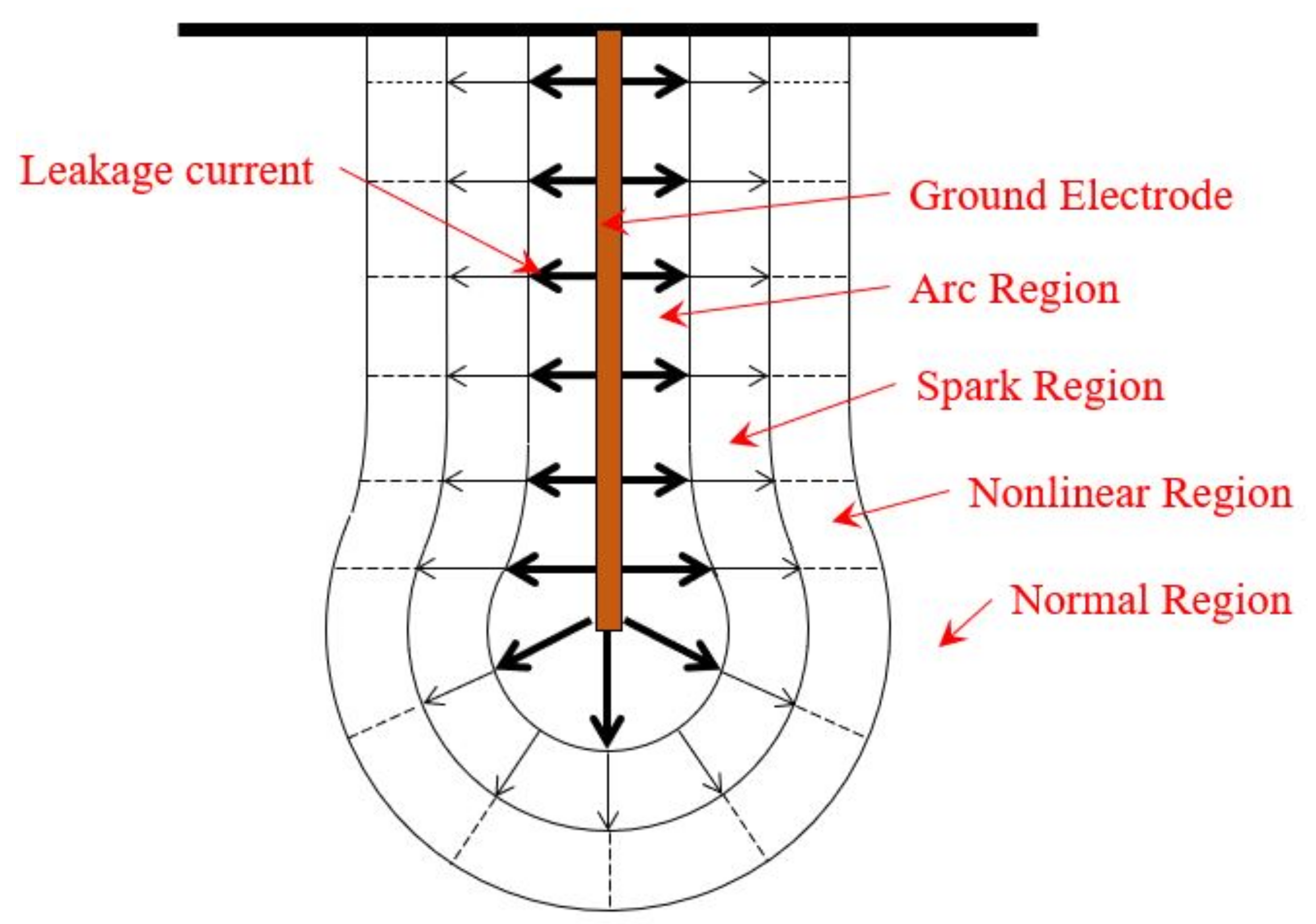
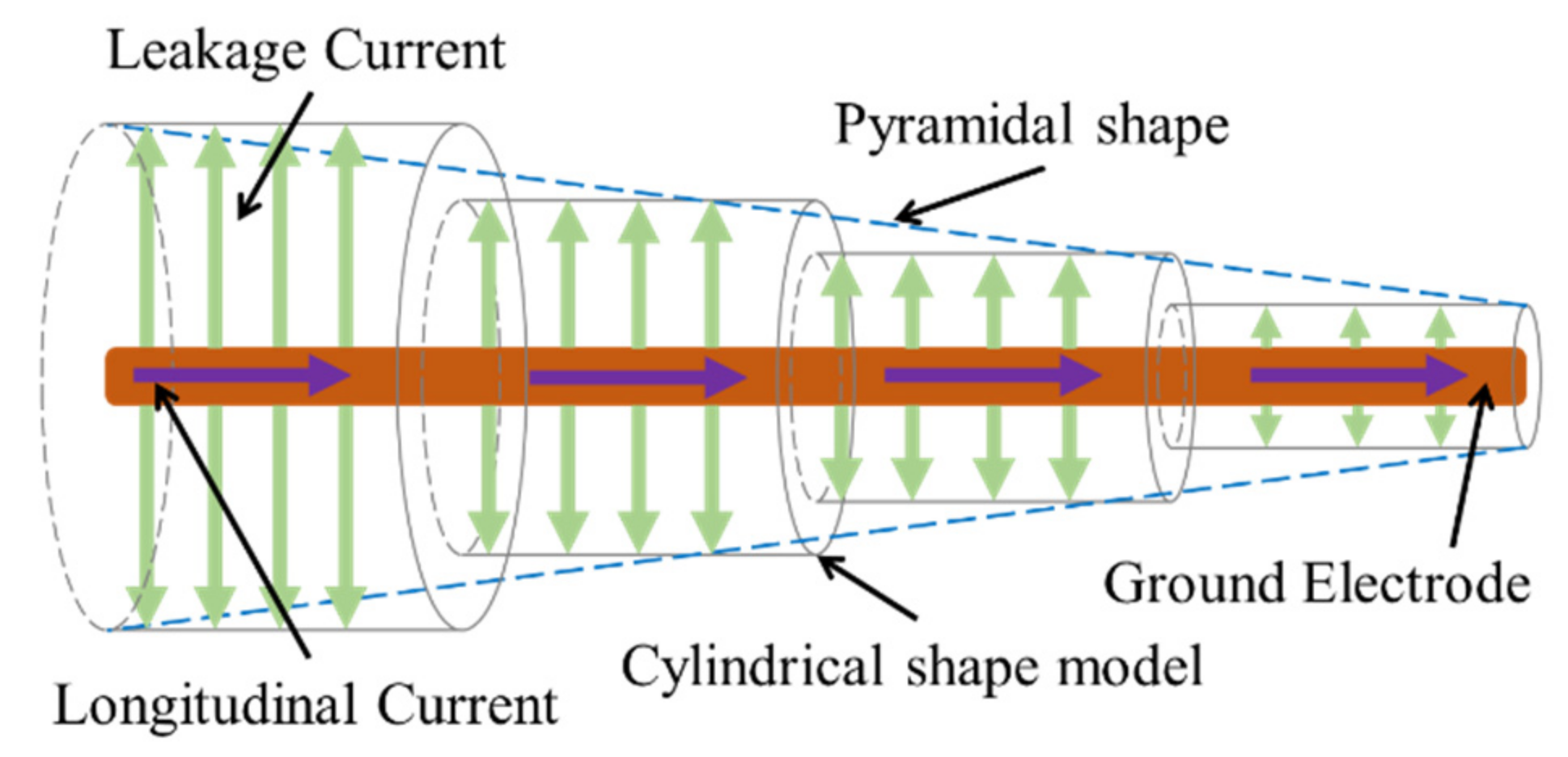
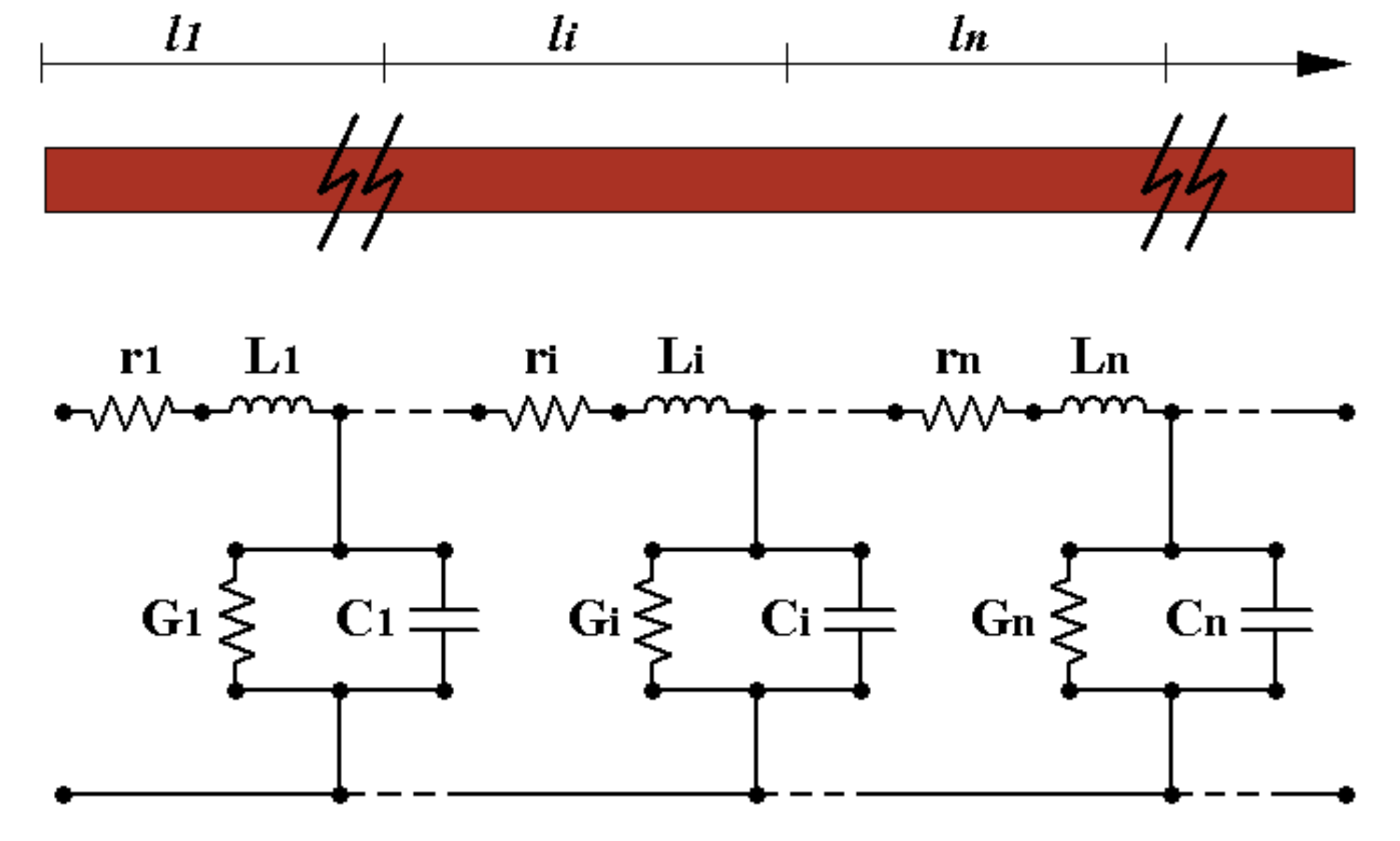
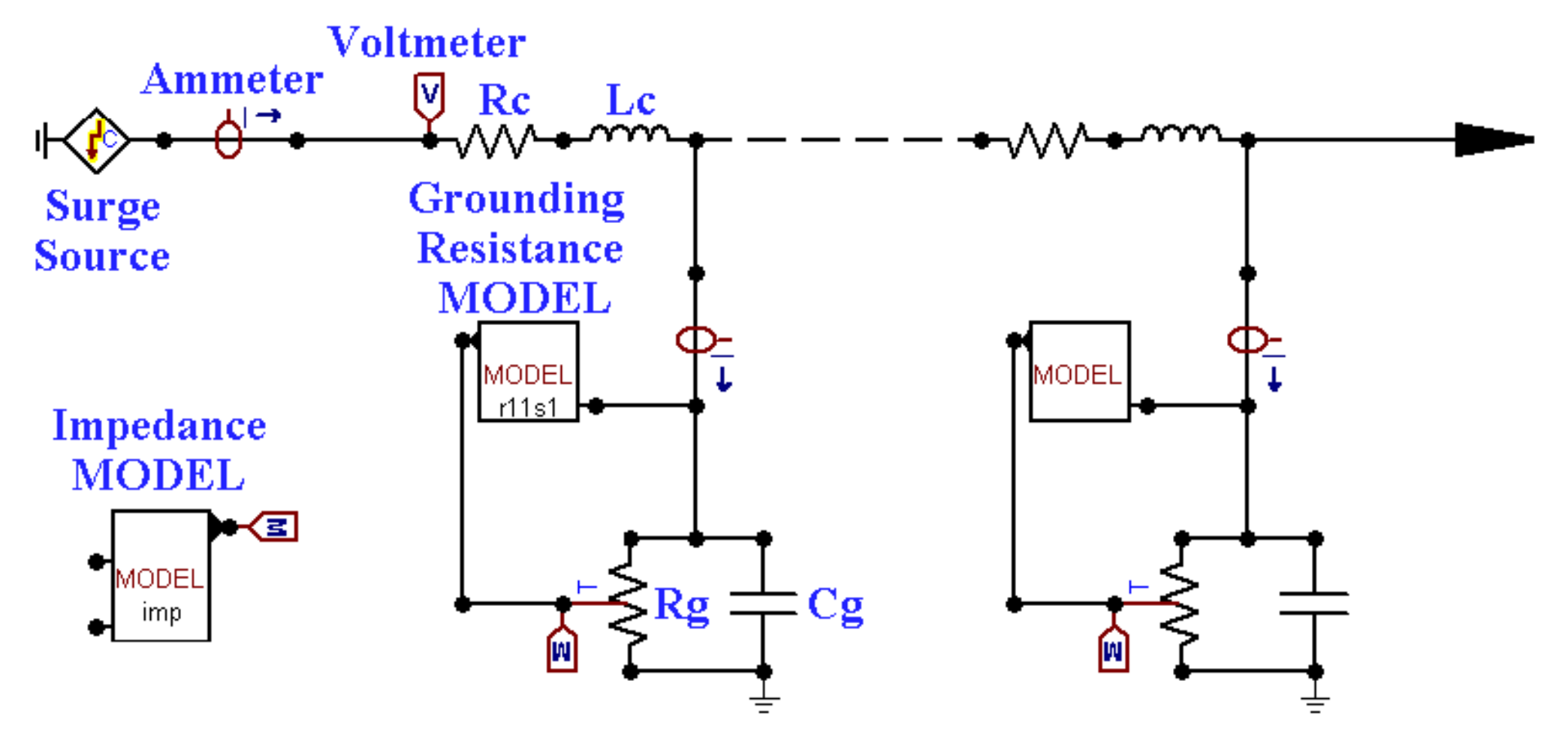
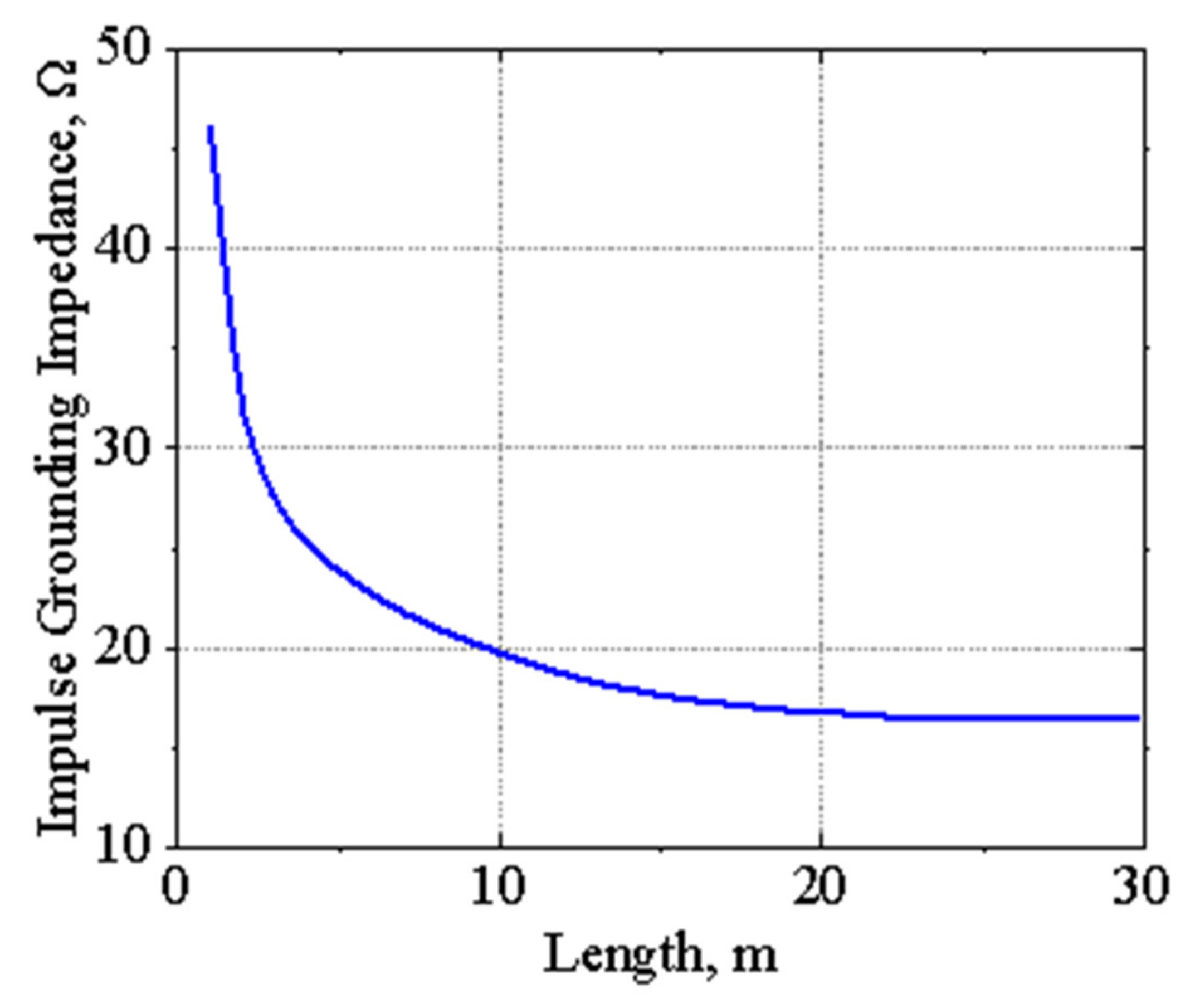
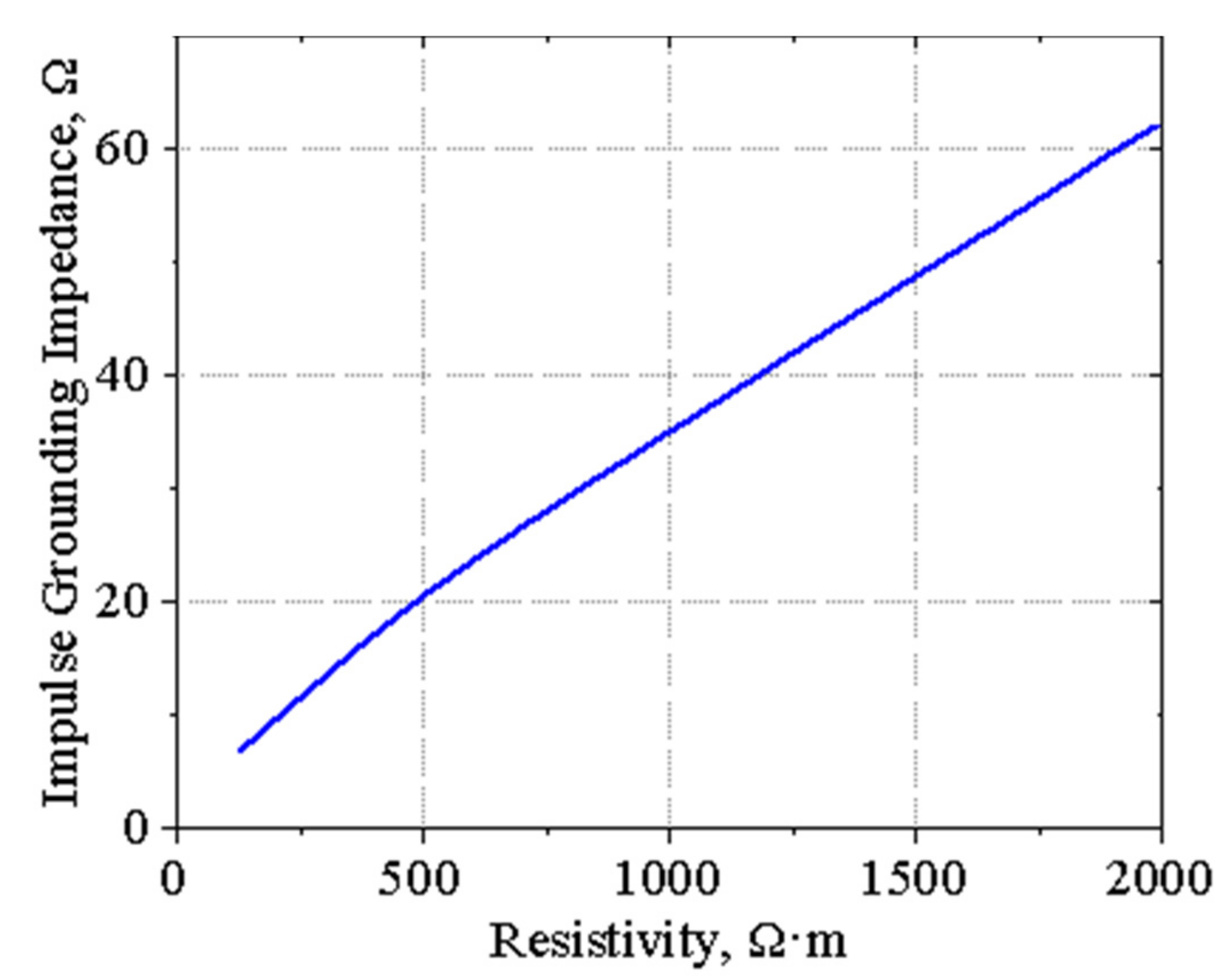
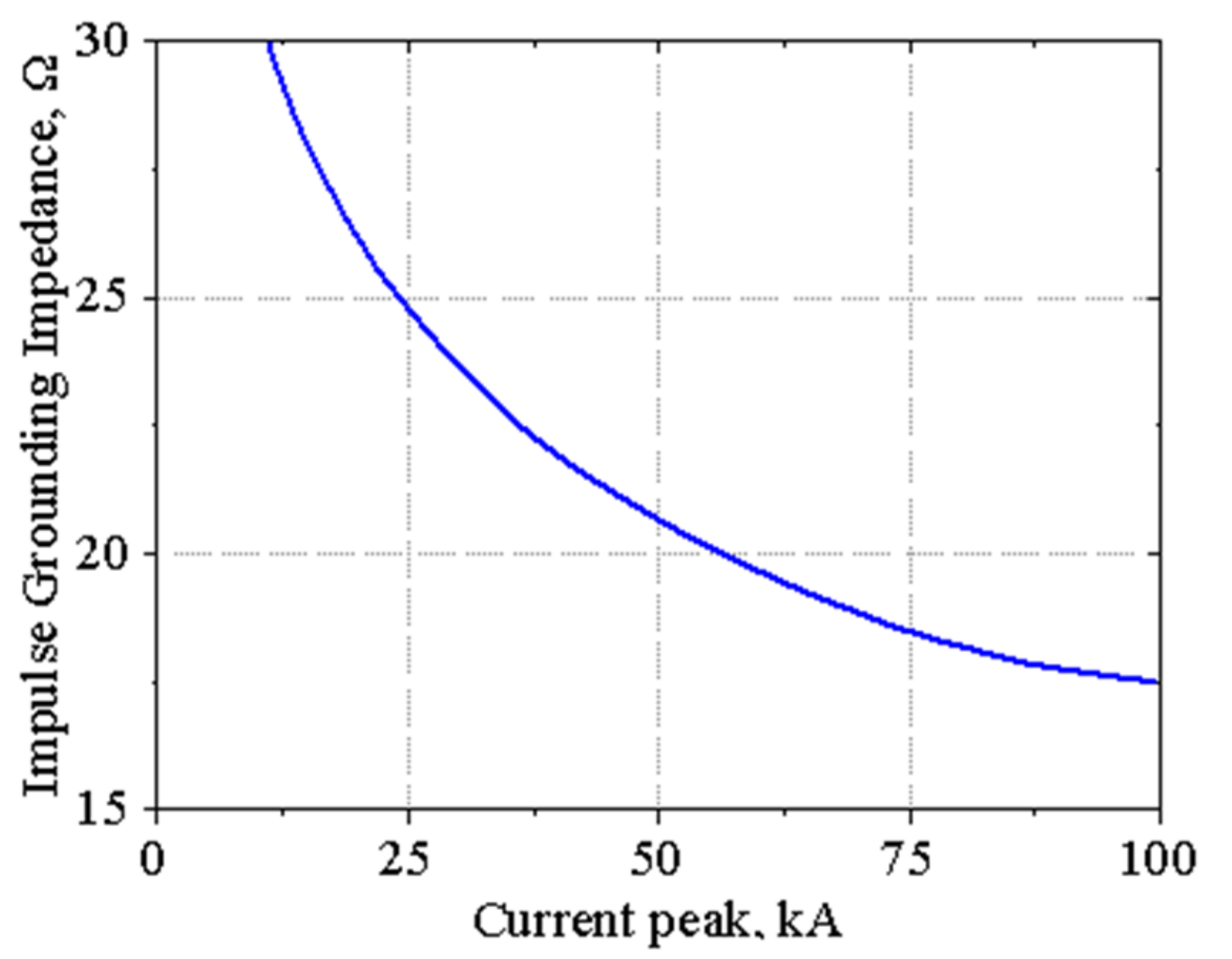

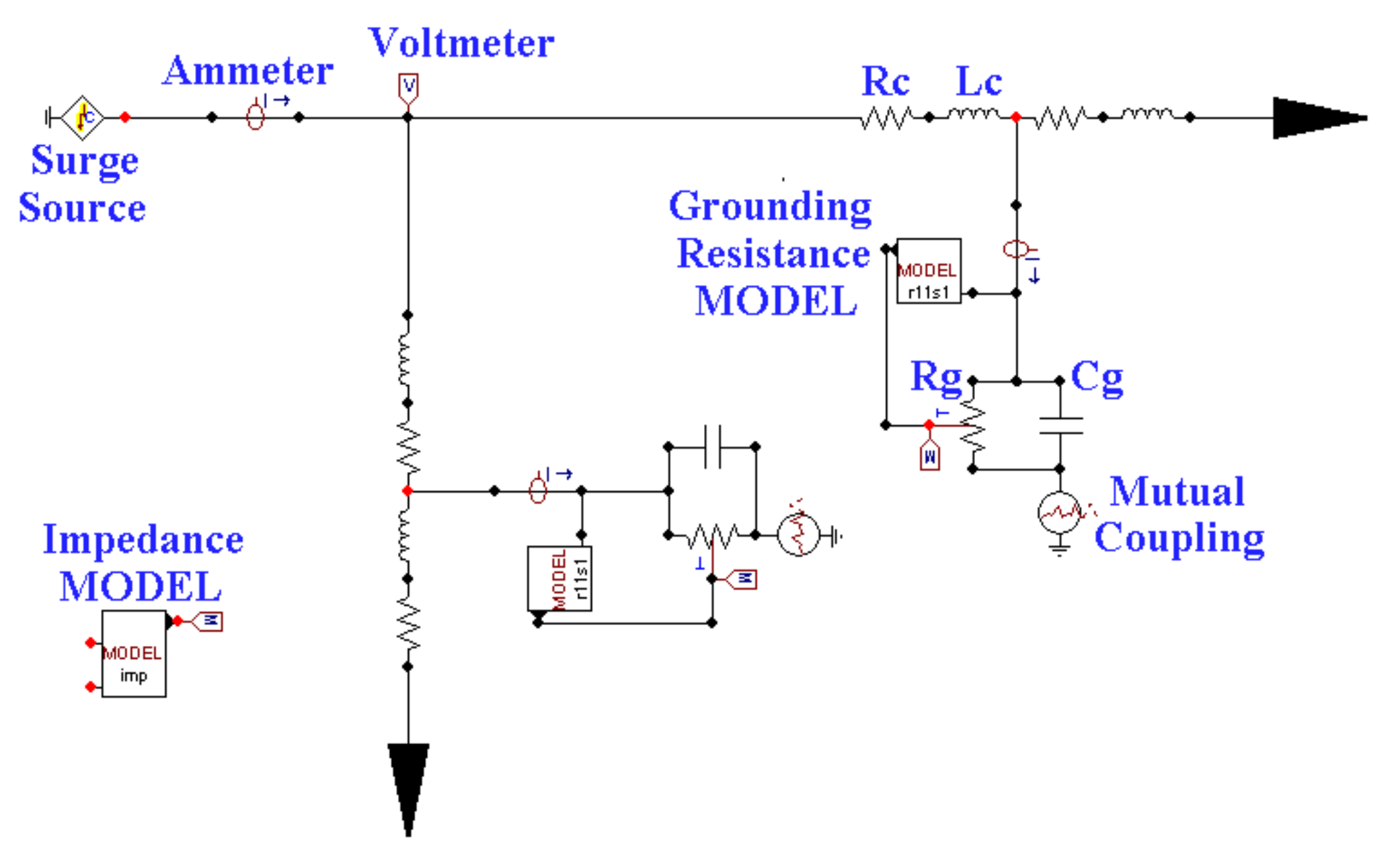
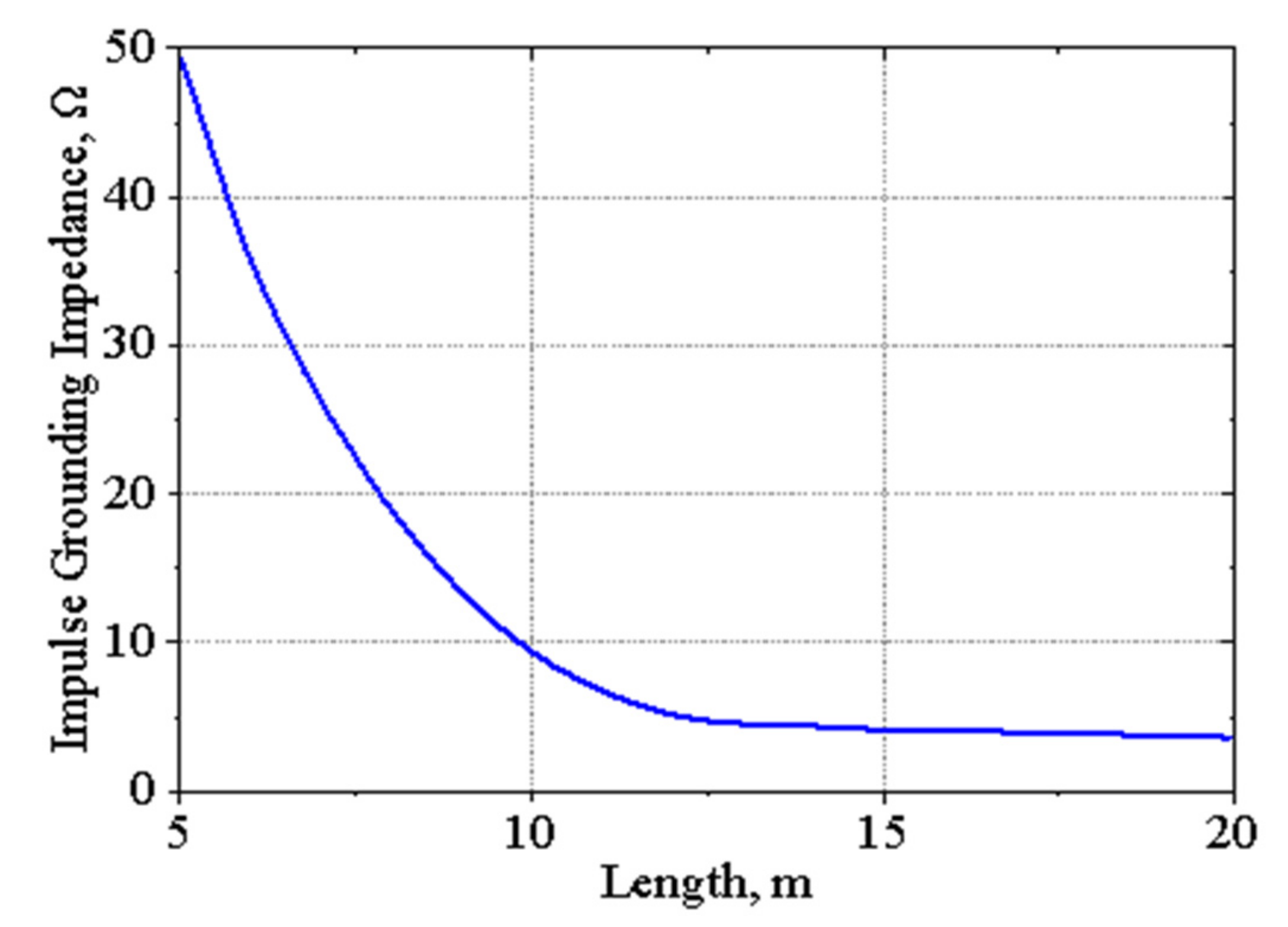
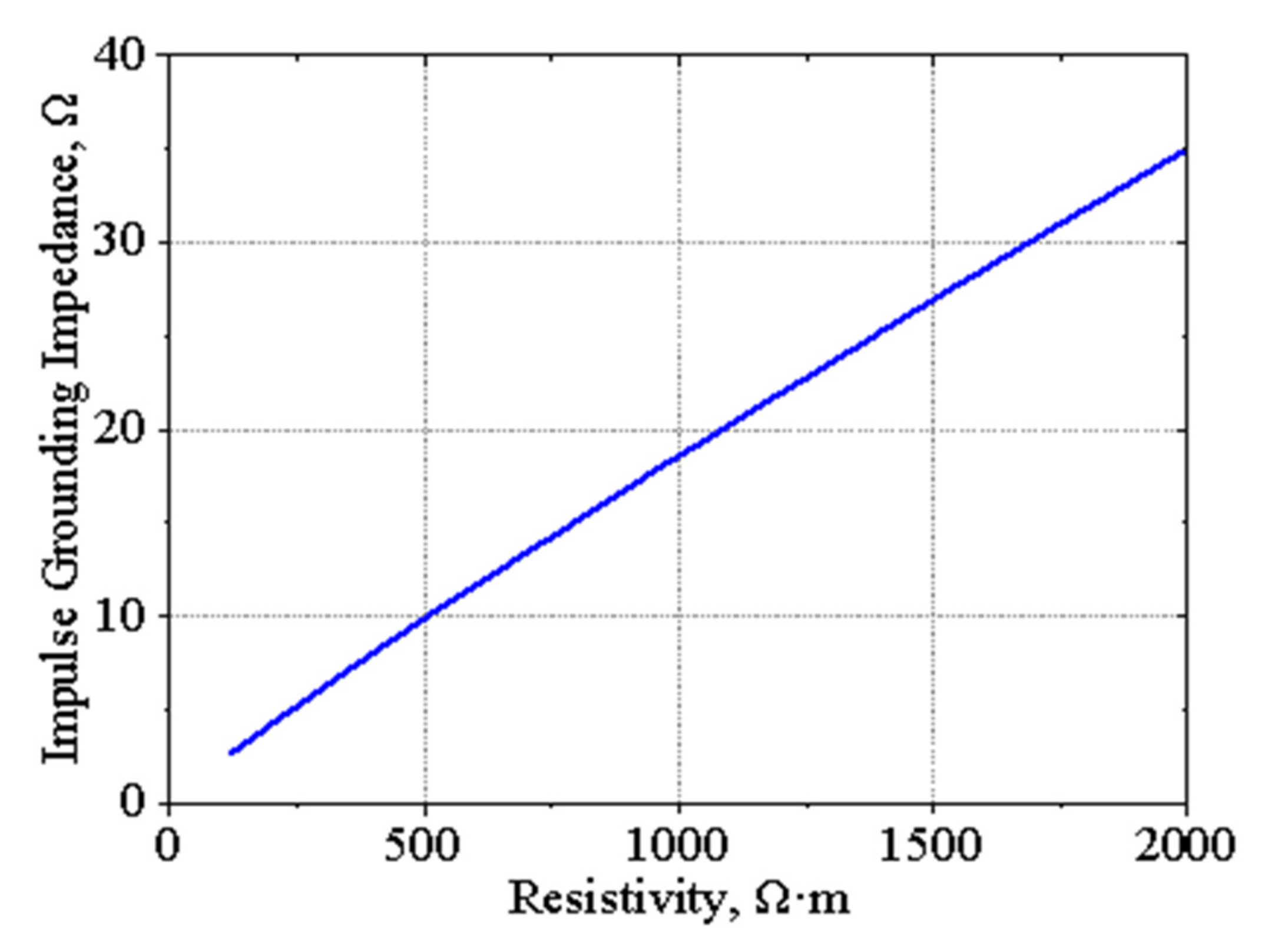

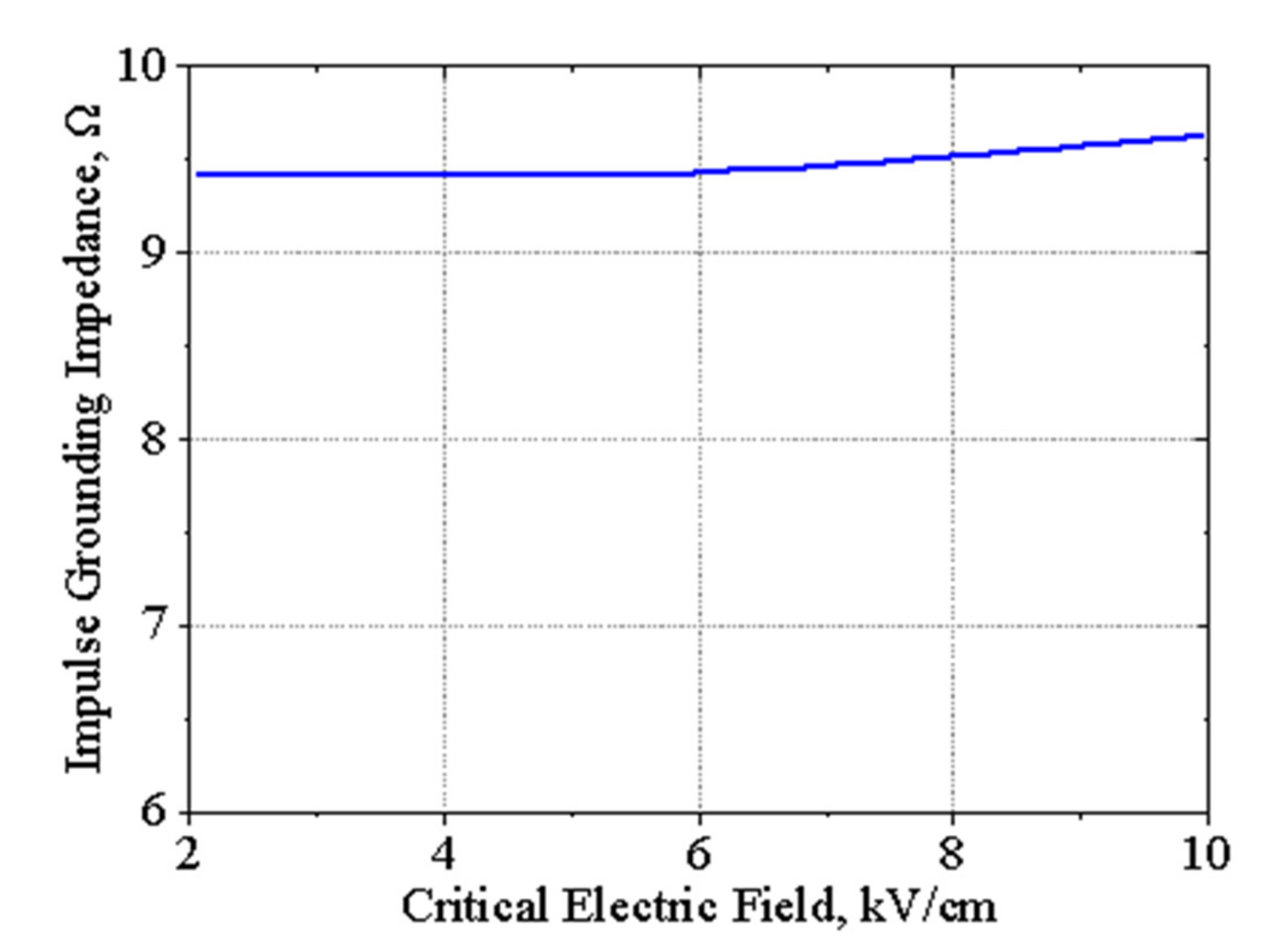

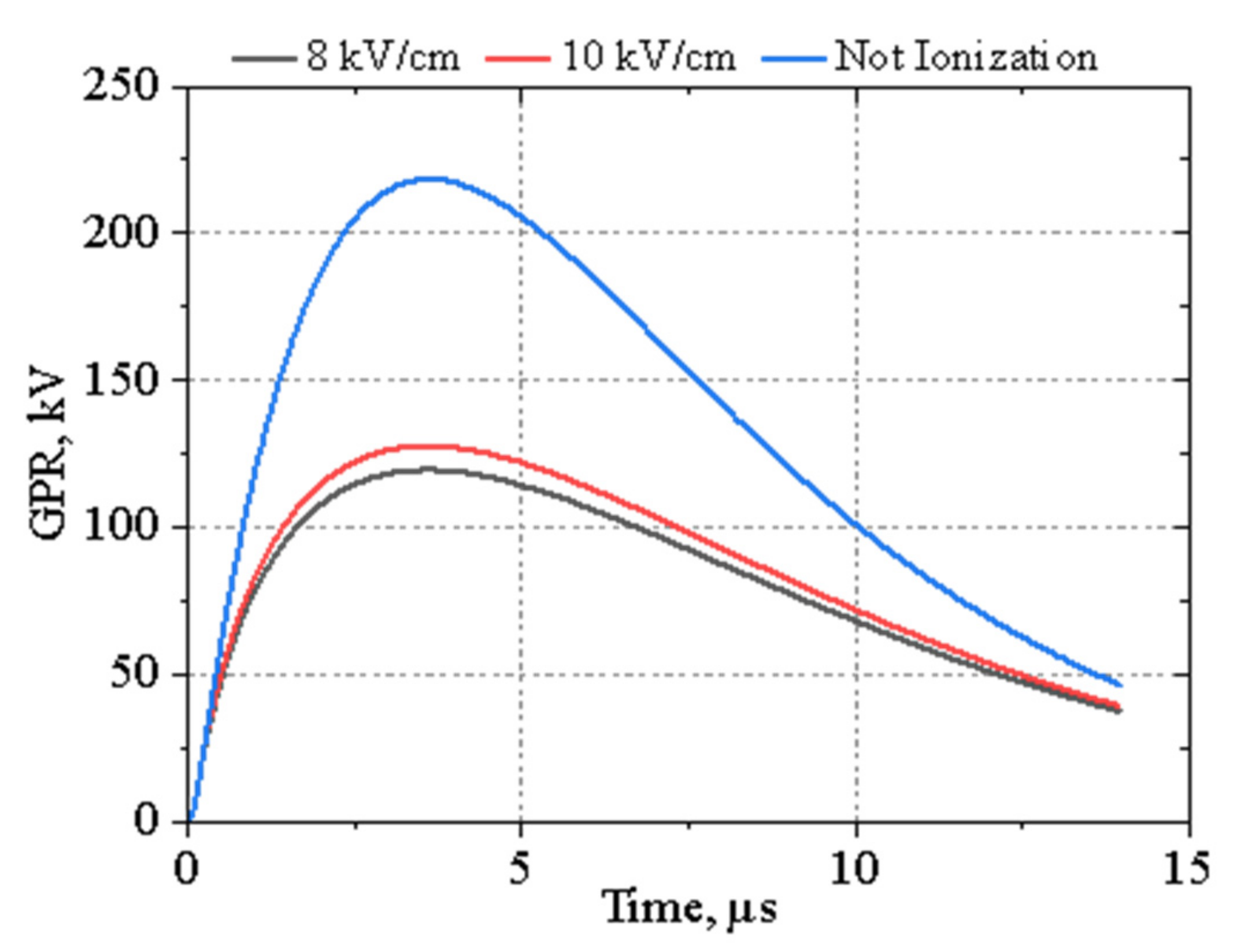
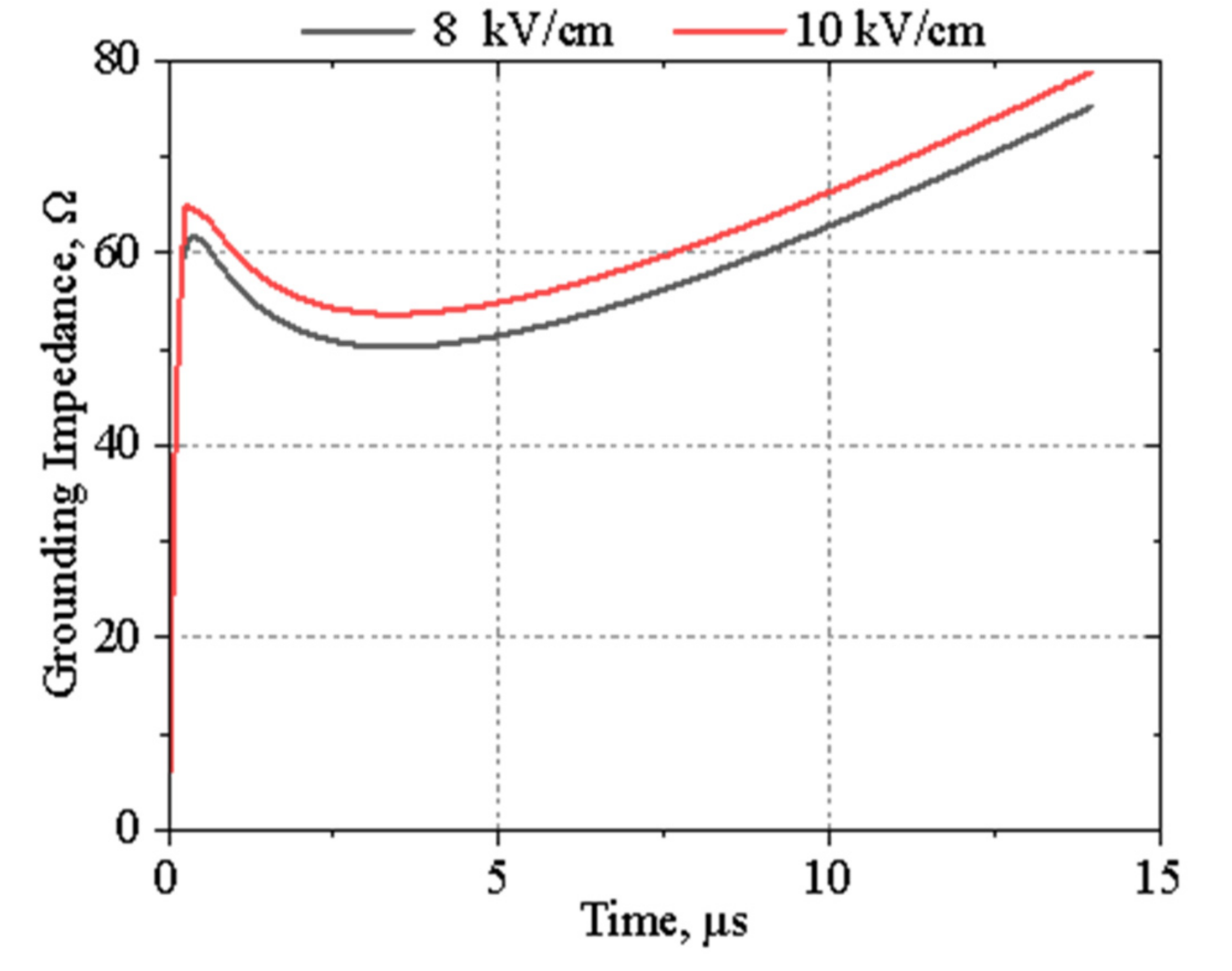

| Parameter | Value | |
|---|---|---|
| Vertical rod | Length—L [m] | 1.5 |
| Diameter—D [m] | 0.014 | |
| Soil | Resistivity—ρo [Ωm] | 160 |
| Parameter | Value | |
|---|---|---|
| Conductor | Resistance, Rc [mΩ] | 0.1637 |
| Inductance, Lc [μH] | 0.15181 | |
| Soil | Grounding Capacitance, Cg [nF] | 0.888 |
Publisher’s Note: MDPI stays neutral with regard to jurisdictional claims in published maps and institutional affiliations. |
© 2022 by the authors. Licensee MDPI, Basel, Switzerland. This article is an open access article distributed under the terms and conditions of the Creative Commons Attribution (CC BY) license (https://creativecommons.org/licenses/by/4.0/).
Share and Cite
Kisielewicz, T.; Cuenca, M. Overview of Transient Simulations of Grounding Systems under Surge Conditions. Energies 2022, 15, 7694. https://doi.org/10.3390/en15207694
Kisielewicz T, Cuenca M. Overview of Transient Simulations of Grounding Systems under Surge Conditions. Energies. 2022; 15(20):7694. https://doi.org/10.3390/en15207694
Chicago/Turabian StyleKisielewicz, Tomasz, and Milton Cuenca. 2022. "Overview of Transient Simulations of Grounding Systems under Surge Conditions" Energies 15, no. 20: 7694. https://doi.org/10.3390/en15207694





